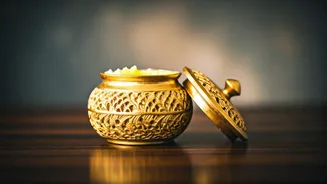Yoga's Gentle Start
Yoga, a practice rooted in ancient Indian traditions, is an excellent pathway to improved physical and mental well-being. For those new to yoga, starting
with accessible poses is crucial. This helps build a strong foundation, preventing injuries and fostering a positive experience. The selected poses are specifically chosen to be gentle on the body while still delivering significant benefits. Regular practice can gradually increase flexibility, strengthen muscles, and calm the mind. These poses cater to individuals of all ages and fitness levels, allowing everyone to participate in the enriching journey of yoga. By focusing on correct alignment and mindful breathing, beginners can unlock the full potential of each pose and embrace the transformative qualities of yoga.
Half Bow Pose (Ardha Dhanurasana)
Ardha Dhanurasana, or Half Bow Pose, is an invigorating backbend that offers multiple health advantages. Lying on the stomach, one bends the knees and reaches back to hold the ankles. This pose stretches the front of the body, stimulating the abdominal organs and improving digestion. It also helps to strengthen the back muscles, improving posture and reducing back pain. To practice Ardha Dhanurasana, ensure your chest is lifted and your shoulders are relaxed. Hold the pose for a few breaths, focusing on deep, even breathing. Avoid straining, and if you have any back issues, modify the pose by only lifting one leg at a time or consulting with a yoga instructor. Remember to listen to your body and move at a pace that is comfortable for you. The Half Bow Pose is a great way to boost energy levels and uplift your mood.
Cobra Pose (Bhujangasana)
Bhujangasana, or Cobra Pose, is another beneficial backbend. It involves lying on the stomach and lifting the chest off the floor, supported by the hands. This pose stretches the spine, strengthens the back muscles, and opens the chest. It helps improve posture, combats fatigue, and stimulates the digestive system. To perform Bhujangasana correctly, keep your elbows close to your body and engage your core. Avoid pushing too far, and ensure your shoulders are relaxed and away from your ears. As you lift your chest, feel a gentle stretch in your abdomen and chest. Breathe deeply and hold the pose for a few breaths before slowly lowering back down. Regular practice of Bhujangasana can increase spinal flexibility and alleviate stress. It is a fantastic pose for counteracting the effects of prolonged sitting and promoting a sense of well-being.
Spinal Twist (Ardha Matsyendrasana)
Ardha Matsyendrasana, or Half Spinal Twist Pose, is a seated twist that brings multiple benefits to the body. This pose gently massages the abdominal organs, improving digestion and detoxification. It also helps to stretch the spine, improving flexibility and relieving back pain. To perform Ardha Matsyendrasana, sit with your legs extended, then bend one knee, placing your foot outside the opposite thigh. Twist your torso towards the bent knee, using your opposite hand for support. The other hand can be used to hold your knee or thigh, assisting in the twist. Breathe deeply, focusing on lengthening your spine with each inhale and twisting gently with each exhale. Avoid over-twisting and listen to your body. Regular practice of this pose improves spinal health and can help calm the nervous system, offering stress relief.
Seated Forward Bend (Paschimottanasana)
Paschimottanasana, or Seated Forward Bend, is a calming pose that promotes relaxation and flexibility. Sitting with legs extended, you reach forward, aiming to touch your toes. This pose stretches the entire back of the body, including the hamstrings and spine, releasing tension and improving posture. It also helps to calm the mind and reduce stress. To practice Paschimottanasana, sit with your spine straight and your legs extended in front of you. Inhale as you raise your arms, and exhale as you bend forward from the hips, reaching for your toes. If you are not able to reach your toes, it is perfectly acceptable to hold onto your shins or ankles. Focus on maintaining a long spine rather than forcing a deep bend. Regular practice can improve flexibility and soothe the nervous system.
Corpse Pose (Shavasana)
Shavasana, or Corpse Pose, is the concluding pose in a yoga session, designed for deep relaxation and integration. Lying flat on your back with your arms at your sides and palms facing up, you close your eyes and release all tension in your body. This pose allows the body and mind to completely relax, reducing stress and promoting mental clarity. During Shavasana, focus on your breath, and allow yourself to sink into the floor. This provides an opportunity for the body to absorb the benefits of the yoga practice. The pose is also a time to quiet the mind and cultivate inner peace. It's often recommended to stay in Shavasana for 5-15 minutes after a yoga session. Shavasana is a critical component of any yoga practice, and it allows the body and mind to fully benefit from the preceding asanas.












